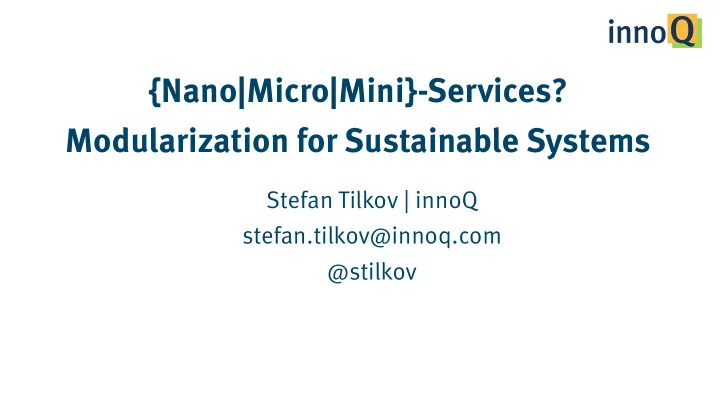

{Nano|Micro|Mini}-Services? Modularization for Sustainable Systems Stefan Tilkov | innoQ stefan.tilkov@innoq.com @stilkov
http://microxchg.io
1. Reviewing architectures
Generic Architecture Review Results Deployment is Building way too Technical debt is features takes complicated and well-known and not too long slow addressed Architectural quality Scalability has reached has degraded its limit “-ility” problems Replacement would abound be way too expensive
Any architecture’s quality is inversely proportional to the number of bottlenecks limiting its evolution, development, and operations
«Insert Obligatory Conway Reference Here»
Conway’s Law Organization → Architecture “Organizations which design systems are constrained to produce systems which are copies of the communication structures of these organizations.” – M.E. Conway
Reversal 1 Organization ← Architecture Any particular architecture approach constraints organizational options – i.e. makes some organizational models simple and others hard to implement.
Reversal 2 Organization ← Architecture Choosing a particular architecture can be a means of optimizing for a desired organizational structure.
2. System boundaries
Modularization Legacy System New System New System
Consolidation Legacy System Legacy System New System
Modernization Legacy System New System
Green fj eld New System Project scope
1 Project = 1 System?
Size Modularization 1-50 LOC single fj le 50-500 LOC few fj les, few functions 500-1000 LOC Library, class hierarchy 1000-2000 LOC Framework + application >2000 LOC multiple applications
System Characteristics Separate (redundant) persistence Internal, separate logic Domain models & implementation strategies Separate UI Separate development & evolution Limited interaction with other systems Autonomous deployment and operations
Domain architecture Macro (technical) architecture
JRuby C# Groovy Scala Clojure Java
NoSQL RDBMS K/V NoSQL RDBMS RDBMS/DWH DocDB
NoSQL RDBMS K/V NoSQL RDBMS RDBMS/DWH DocDB Micro architecture
Module C Module B Module A Persistence Logic UI
UI UI UI Logic Logic Logic Persistence Persistence Persistence System A System B System C
Assumptions to be challenged Large systems with a single environment Separation internal/external Predictable non-functional requirements Clear & distinct roles Planned releases Built because they have to be
http:/ /12factor.net
App characteristics Separate, runnable process Accessible via standard ports & protocols Shared-nothing model Horizontal scaling Fast startup & recovery
Microservice Characteristics small each running in its own process lightweight communicating mechanisms (o fu en HTTP) built around business capabilities independently deployable minimum of centralized management may be written in di fg erent programming languages may use di fg erent data storage technologies http:/ /martinfowler.com/articles/microservices.html
System Characteristics Separate (redundant) persistence Internal, separate logic Domain models & implementation strategies Separate UI Separate development & evolution Limited interaction with other systems Autonomous deployment and operations
In search for a name … Executable component Sovereign system Bounded system Small enough system System Autonomous system Self-contained system Large enough system Cohesive system Domain unit Logical node Independent system Self-sufficient component Small system Full-stack service Not-so-micro-service
Self-Contained System (SCS)
SCS Characteristics Autonomous web application Owned by one team No sync remote calls Service API optional Includes data and logic No shared UI No or pull-based code sharing only
SCS App Microservice Size (kLoC) 1-50 0.5-10 0.1-? State Self-contained External Self-contained # per Logical System 5-25 >50 >100 Communication between units No (if possible) ? Yes UI Included Included External (?) UI Integration Yes (web-based) ? ?
But why?
Isolation
(Independent) Scalability
Localized decisions
Replaceability
Playground e fg ect
Afraid of chaos?
Necessary Rules & Guidelines Cross-system System-internal Responsibilities Programming languages UI integration Development tools Communication protocols Frameworks Data formats Process/Workflow control Redundant data Persistence BI interfaces Design patterns Logging, Monitoring Coding guidelines
Web-native front-end integration
Server-side integration Browser Examples : Backend 1 ESI-Caches SSI Portal Server UI 1 Frontend Server UI 2 Backend 2 HTML Page
Client-side integration Browser Backend 1 UI 1 Examples : AJAX Proprietary Frameworks UI 2 Backend 2 HTML Page
Links Browser Backend 1 HTML Page 1 <<creates>> Backend 2 HTML Page 2 Asset <<creates>> CSS Server
Server-side integration options ESI (Portal server) Edge integration Homegrown REST RMI Backend call RPC WS-* Feeds Storage DB replication Chef, Puppet, … Deployment Build tools Asset pipeline Git/SVN submodules Gems Development Maven artifacts
Client-side integration options JS Widgets Client call SPA-style oEmbed Unobtrusive JS Replaced link ROCA-style Magical integration concept Link
Summary Explicitly design system boundaries Modularize into independent, self-contained systems Separate micro and macro architectures Be aware of changing quality goals Strike a balance between control and decentralization
Thank you! Stefan Tilkov, @stilkov stefan.tilkov@innoq.com Questions? http:/ /www.innoq.com/blog/st/ Comments? Phone: +49 170 471 2625 innoQ Schweiz GmbH innoQ Deutschland GmbH Krischerstr. 100 Ohlauer Straße 43 Robert-Bosch-Straße 7 Radlkoferstraße 2 Gewerbestr. 11 40789 Monheim am Rhein 10999 Berlin 64293 Darmstadt D-81373 München CH-6330 Cham Germany Germany Germany Germany Switzerland www.innoq.com Phone: +49 2173 3366-0 Phone: +49 2173 3366-0 Phone: +49 2173 3366-0 Telefon +49 (0) 89 741185-270 Phone: +41 41 743 0116
Recommend
More recommend